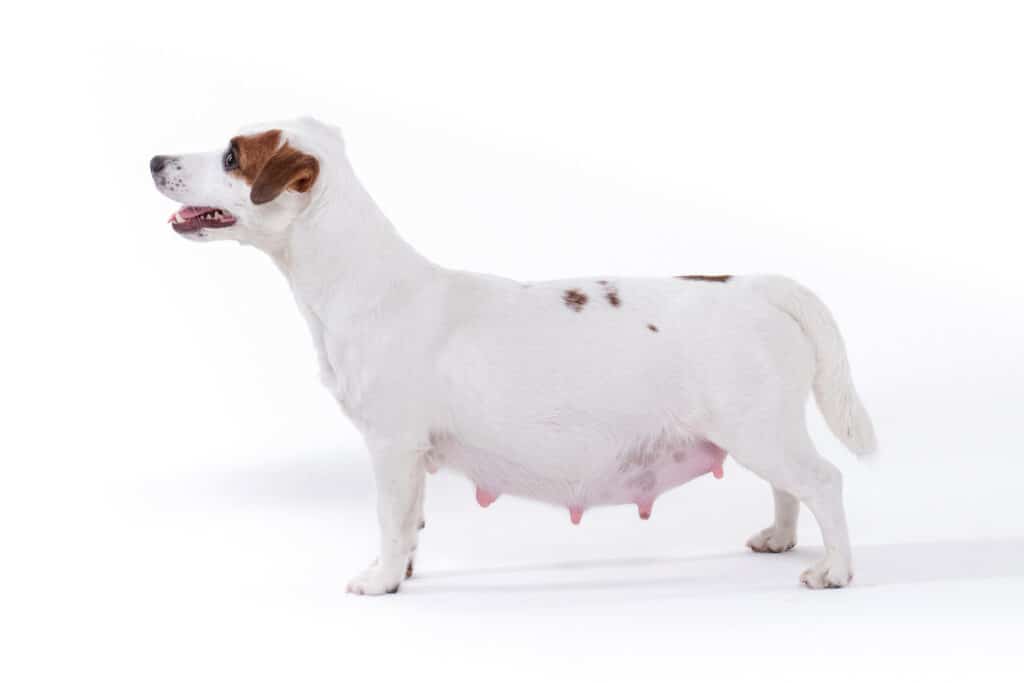Before breeding ensure that your prospective Jack Russell Terrier brood bitch is in top physical condition. An underweight or overweight bitch may lack exercise tolerance or physical stamina and have trouble whelping (giving birth).
The ideal age for a Jack Russell Terrier to safely deliver a litter of puppies is between 2 and 5 years of age. You should not consider breeding from a bitch until she is fully grown and mature. Maturity is reached around 1.5 to 2 years of age.
It is equally advisable to avoid breeding from a bitch that is too mature, however that upper limit for this will depend on your dog, her reproductive history and your vet’s specific advice.
It is important to take your Jack Russell Terrier to your veterinarian for a physical check-up before she comes in heat. All vaccinations should be up to date for the duration of your dog’s pregnancy, so check with your vet about this before you mate you bitch.
How long does a Jack Russell Terrier female stay in heat?
Female Jack Russell Terriers reach sexual maturity around the age of 9 to 10 months, although this can be as early as four months of age in some females. Often the first estrus or ‘heat’ is “silent” or does not have clinical signs associated with estrus. It is not recommended that a bitch has puppies on her first heat.
Female Jack Russell Terriers that have not been spayed usually have 2 heats per year, about 6 months apart. It is important to remember they can become pregnant during their very first heat.
There are several signs that typically occur when a bitch is in heat:
- Increased alertness and restlessness
- Swollen vulva
- More frequent urination, which could lead to accidents
- Vaginal bleeding
A female Jack Russell Terrier’s heat cycle lasts for 2 to 3 weeks and can be broken down into 3 phases:
- Proestrus – this first phase of the heat cycle usually lasts around 9 days. The female Jack Russell Terrier will begin to attract males; however, she will typically reject their advances until the next phase.
- Oestrus – this second phase can last anywhere from 3 to 7 days. During this phase ovulation occurs and pregnancy is most likely to happen. The female Jack Russell Terrier is most receptive to the male’s advances during this phase.
- Diestrus – this is the final phase, typically occurring around day 14. When this happens, the female Jack Russell Terrier will no longer allow mating.
The heat cycle is considered to be finished when the vulva returns to normal size, not when bleeding stops. The female Jack Russell Terrier then enters a period called anoestrus, which is the interval between one heat cycle and the following. This typically lasts around six months.
Mating
Before the serious business of mating begins, the female (bitch) and the male Jack Russell Terrier will likely engage in some playful courting behaviours.
When the male mounts the bitch, there is a vaginal reflex that locks the two dogs together until the act of mating is complete. This can take anywhere from for 15 to 30 minutes. This lock phenomena may seem strange to us, especially if the male executes a 180-degree rotation but it is crucial to avoid attempting to separate them because doing so could result in injury.
Fertilization may occur several days after mating since sperm can survive in the uterus for up to 7 days. It is important to remember that mating does not guarantee pregnancy; it is possible that the mating took place before the bitch has reached peek fertility.
To improve the likelihood that a pregnancy will occur, mating is frequently attempted twice, with a two-day gap between each try. However, several tries could be necessary, especially if the partners lack prior experience. Estimation dates for whelping (giving birth) is usually based on mating dates.
Pregnancy
A female Jack Russell Terrier’s pregnancy lasts around 63 – 65 days but can range anywhere between 60 and 67 days.
There are several methods of pregnancy diagnosis. Palpation can be done from 20 to 30 days. This however has limitation and may not pick up puppies in obese Jack Russell Terriers or those with only one or two pups.
More accurate confirmation of pregnancy and expected whelping dates can be done with blood tests which can detect signs of relaxin. This hormone is produced in greater quantities during canine pregnancy.
Pregnancy can be broken down into 4 stages:
Stage I: Weeks 1 – 3
In these early weeks, your Jack Russell Terrier will feel nauseous, sometimes vomiting and whining. She may also experience a change in appetite and eat less rather than more. This is normal and should only last for 7-10 days.
Your jack Russell Terrier’s nipples will naturally grow in size around the two-week mark and become more raised and noticeable. Due to the increased blood flow to the area it’s also likely her nipples will turn darker than normal. Don’t worry though, these changes are completely normal as her body prepares for milk production.
Stage II: Weeks 3 – 6
During this stage, your Jack Russell Terrier’s belly will appear fuller and rounder as part of a natural protective process by her body to help protect her puppies from impact.
An ultrasound can detect pregnancy from as early as 21 days. However, they are more accurate between 28 to 35 days. Around the 4-week mark, a vet will be able to detect the puppies’ heartbeats with a stethoscope.
It is important to note that Jack Russell Terrier females can go through false pregnancies. This means they exhibit all the signs of pregnancy, including mammary development and nesting behavior but are not actually pregnant. This is easily identified by performing ultrasound.
By this stage your terrier’s morning sickness should have passed and her appetite will return. She should be fed a high-quality, well-balanced diet that contains at least 29 percent protein and 17 percent fat. Only 30 percent of fetal growth occurs during these first few weeks, so the actual amount of food she requires during the first 5 to 6 weeks of pregnancy does not need to be increased significantly (10 percent maximum).
Stage III: Week 6 – 9
Ultrasounds are a valuable tool in detecting pregnancy but are not always a reliable method in determining the number of puppies. After the 45 day mark an x-ray can give an accurate picture of how many puppies your Jack Russell Terrier is expecting.
It will become increasingly obvious that your Jack Russell Terrier is pregnant, and her belly will become fully round and padded. By gently holding your terrier’s belly you will be able to feel her puppies moving around. The size of the puppies now will limit her mobility, so it will become increasingly difficult for her to move around.
Fetal growth rapidly increases during last 3 to 4weeks of pregnancy. Your Jack Russell Terrier’s food intake should be gradually increased up to 1 ½ times her normal requirements.
Choosing a high energy, low bulk diet is best to ensure she is adequately nourished and has nutritional reserves for whelping and lactation. The best food to feed your terrier is a high-quality puppy food which has increased calcium and protein levels. Smaller, more frequently meals may be required to ensure adequate intake.
Stage IV: Week 9 + (The puppies are coming any time now!)
Any time now your Jack Russell Terrier will give birth to her puppies. Changes in her behaviour are a good sign the puppies are coming. For instance, she will create a ‘nest’ in a quiet and safe spot. She will also begin moving around a lot, acting anxious and possibly start whimpering.
Especially if this is her first litter of puppies (and you can afford it), is a good idea to ask a vet to supervise.
Preparing for Delivery
While whelping is a beautiful and natural process, it can cause quite a mess, so it is best to prepare a ‘nest’ in the house for your Jack Russell Terrier to minimise this. It is a good idea to begin organising this around 2 weeks prior to whelping.
A good spot for a nest is a quiet place, such as a closet or small room. Avoid setting up the nest in a busy area, as whelping may be delayed or interrupted if strangers are present, or it is too noisy.
It is a good idea when setting up a nest that it is ‘contained’. A purposely built whelping box is ideal as it keeps the puppies safely contained, protects them from the cold, and ensures they aren’t crushed by their mother. As well as this, the sides are low enough for your terrier to come and go freely.
The box should be lined with several layers of newspapers or an old blanket. This provides an absorbent layer which will allow the bitch to tear up and reorganize according to her own needs and absorb mess at the time of whelping.
Newborn puppies cannot regulate their body temperature effectively so warmth in the nest is essential. You can use a puppy safe heat pad that is designed to provide warmth without getting too hot to help the pups stay warm. If a heating pad is used, it should be placed on the low setting and covered with a towel to prevent overheating. A hot water bottle could also be used and should be covered with a towel.
Newborn puppies may be unable to move away from the heat source so care must be taken to prevent overheating. To avoid overheating there should also be a cooler corner of the whelping box that the pups can crawl to if needed.
It is important to allow your Jack Russell Terrier to become accustomed to the nest well in advance of whelping. Despite being familiar with her nest, sometimes a terrier in labor will become confused and insist on having her puppies near her owner.
In this case it can be less traumatic for your Jack Russell Terrier to compromise (within reason) on where she whelps. Once whelping has finished you can gently move her back to the nest that she has already been introduced previously.




![How Much Exercise Does A Jack Russell Terrier Need? [Complete guide for all life stages]](https://jackrussellsunleashed.com/wp-content/uploads/2022/03/iStock-1143749718-1024x683.jpg)
![My Jack Russell Terrier Hates Baths! [4 reasons why & 5 helpful bath time tips]](https://jackrussellsunleashed.com/wp-content/uploads/2022/03/iStock-613556174-1024x683.jpg)
